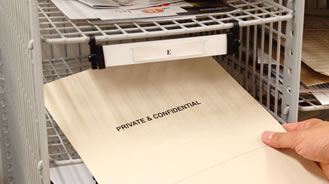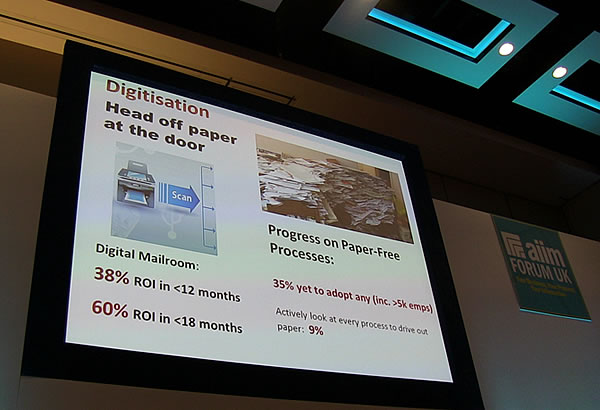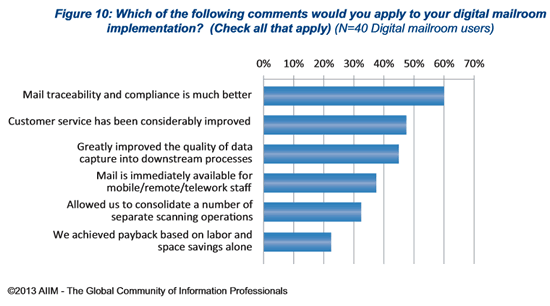 In a context of digital transformation, organizations invest in four key areas according to AIIM (the association of information management professionals): improving engagement, automating processes, improving insights and reducing risks.
In a context of digital transformation, organizations invest in four key areas according to AIIM (the association of information management professionals): improving engagement, automating processes, improving insights and reducing risks.
The second area of investment – business process automation – is not just a key digitalization priority but also a vast topic, covering many technologies and obviously lots of processes which can be automated. However, as AIIM’s Doug Miles, said at the AIIM Forum 2015 in the UK, ‘we see that paper-based processes are still the norm rather than the exception, killing productivity’. And slowing down digital transformation in more than one way.
There are many compelling reasons to deal with this challenge, customer service – and, along with it, customer experience – being a key one. Among the ways to get rid off the paper obstacle in process automation: head off paper at the door using a digital mailroom, as Doug Miles reminded. Good old mailroom automation with its increasingly multi-channel, multi-format and multi-source dimension and the addition of artificial intelligence (AI) and Robotic Process Automation (RPA), the latter a form of smart process applications (SPAs) in practice.

Mailroom automation: the rise of the digital mailroom – what and why
Traditionally serving as the hub of the internal mail system and the interface with the external mail as Wikipedia defines it, the mailroom is still the center of paper-based correspondence in several organizations.
Others have outsourced it to BPO (Business Process Outsourcing) service providers or embraced a DPO (Document Process Outsourcing) model.
The digital mailroom is picking up speed. Of course, digitization in a mailroom automation context isn’t new and mailroom automation doesn’t totally equal the concept of the digital mailroom as we know it today. The multi-anything aspect and the ‘intelligent’ dimension plays an increasing role. Moreover, mailroom automation is not always a matter of big projects. Think about how ample governments with ample government bodies and divisions within those bodies tackle the automation of incoming mail and document types (e.g. incoming invoices) using a rather siloed scanning and invoice handling approach, leveraging electronic document management or case management systems in connection with business applications such as ERP as they operate in these ways and only start or plan to start a journey to a more integrated, let alone end-to-end processes.
From centralized document scanners and capture solutions to digital hubs
The first wave of mailroom automation was strongly related with the rise of powerful document scanners and document capture solutions, leading to the mixed, yet often centralized mailroom we still see and which in several circumstances still make sense.
In recent years, among others driven by the need for speed, this centralized model has been under pressure as the need to capture documents and mail at the earliest point of entry in the organization, leads to more hybrid and decentralized models. Central mailrooms mainly exist in very large organizations while smaller companies and branch offices often have hybrid approaches. As always, it’s not a “this versus that” story and the ideal solution doesn’t exist. It all depends on the industry and business (and customer) needs, among other.
Large BPOs or service bureaux who specialize in mailroom automation, de facto often are document capturing and processing hubs where digital is a key part of the equation. This isn’t new either. In fact, a big part of document imaging and capturing and related digitization processes today still happens in mailrooms. When we first started talking about digital mailrooms, it was essentially in this context of digitization and the automation of incoming mail processes.
Benefits of implementing a digital mailroom
In “Winning the Paper Wars”, AIIM summarizes the key benefits of implementing a digital mailroom:
- Better mail traceability and compliance.
- Considerably improved customer service.
- Enhanced quality of data capture into downstream processes enhanced.
- Mail is immediately available for the remote staff.
- Ability to consolidate several separate scanning operations.
- Payback based on labor and space savings alone.

Mailroom automation in the digital mailroom: the multi-channel and omni-channel context
On top of these benefits, the central place of the customer and efficiency/costs, it’s important to look at the digital mailroom from the mentioned perspective of the steep increase of multi-channel and omni-channel inbound communications we’ve been witnessing for many years now.
Capturing (incoming) data and correspondence today is about much more than paper and includes email and many more information channels, sources and formats, mainly unstructured.
For most organizations, dealing with such multi-channel inbound communications (and the resulting unstructured data) de facto mostly happens in an ad hoc way. Another important number of organizations work in separate ways, depending on the nature of the inbound communications. A typical example is how routing and handling for paper, electronic and social communications are isolated in many cases.
It’s in the multi-channel customer (service and experience) context that the core evolutions in the digital mailroom occur with value as a key differentiator. And it’s also here that RPA, AI and so forth are increasingly finding their way, as will other technologies.

